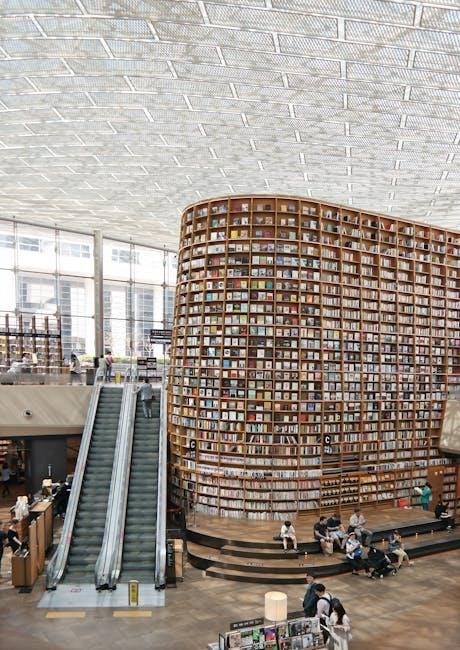A Game Design Document (GDD) is a detailed blueprint outlining a video game’s mechanics, story, art, and sound. It ensures clarity and alignment among developers, guiding the creation process from concept to completion while preventing misunderstandings. A well-structured GDD evolves with the project, serving as a central reference for the team and stakeholders, ensuring a cohesive and polished final product.
1.1 What is a Game Design Document (GDD)?
A Game Design Document (GDD) is a comprehensive guide detailing a video game’s concept, mechanics, story, art style, and technical requirements. It serves as the blueprint for the development team, ensuring everyone understands the vision and scope. The GDD outlines gameplay mechanics, user interface, controls, levels, and audio-visual elements. It evolves throughout the project, adapting to changes while maintaining consistency. A well-crafted GDD is essential for aligning the team and stakeholders, ensuring the final product meets the intended design and player experience. Reference samples, like a GDD sample PDF, provide practical templates for developers to structure their documentation effectively.
1.2 Importance of a GDD in Game Development
A Game Design Document (GDD) is vital for ensuring clarity and alignment among team members. It outlines the game’s vision, mechanics, and requirements, preventing misunderstandings and scope creep. The GDD serves as a central reference, guiding development from concept to completion. It helps maintain consistency, organizes ideas, and adapts to changes, ensuring the final product aligns with the original vision. A well-crafted GDD also aids in project management, reducing risks and improving efficiency. Reference materials, like a GDD sample PDF, provide developers with practical templates to maintain quality and direction throughout the process.

Structure of a Game Design Document
A GDD typically includes sections like project overview, gameplay mechanics, art style, and technical requirements. It provides a clear framework for organizing ideas and ensuring alignment among team members, making it easier to track progress and maintain consistency throughout development.

2.1 Key Sections of a GDD
A GDD typically includes essential sections such as a project overview, gameplay mechanics, art and audio requirements, story and narrative, level design, technical specifications, and a development timeline. These sections ensure that all aspects of the game are thoroughly documented, providing a comprehensive guide for the development team. Additional sections may cover user interface design, target audience analysis, and marketing strategies. Each section should be detailed enough to avoid ambiguity while remaining flexible for iterative changes during development.
2.2 How to Organize Your GDD for Clarity
Organizing a GDD for clarity involves structuring it into logical sections and subsections, ensuring easy navigation. Start with an overview, followed by gameplay mechanics, art, and narrative. Use clear headings, bullet points, and visuals to break down complex information. Regular updates and version control are crucial to maintain accuracy. Including a table of contents and cross-referencing sections helps team members quickly locate information. Accessibility and readability are key to ensuring the document serves its purpose effectively throughout the development process.

Game Design Document Sample PDF Overview
A sample GDD PDF provides a structured template for game development, detailing gameplay mechanics, art style, and sound requirements. It offers a clear framework for developers to follow, ensuring consistency and organization throughout the project.
3.1 Where to Find High-Quality GDD Templates
High-quality GDD templates can be found online through Google searches, game development communities, and professional tools. Websites like GitHub, game development forums, and software development platforms offer downloadable templates. Additionally, game engines like Unity and Unreal Engine provide comprehensive GDD examples. Professional tools such as ChatGPT and specialized game design software also offer detailed templates. Many developers share their GDDs publicly, providing real-world examples for inspiration and guidance.

3.2 Analyzing a Sample GDD for Better Understanding
Examining a sample GDD provides insights into its structure and content. It typically includes sections like gameplay mechanics, story, and art style. By reviewing real-world examples, developers can understand how to organize ideas effectively. For instance, the GDD for Monaco offers a detailed template, while others, like the Van Buren document, showcase extensive world-building. Analyzing these samples helps identify best practices, such as clear communication of design intent and thorough documentation of technical requirements. This process ensures a robust foundation for game development.

Best Practices for Creating a GDD

Maintain clear communication, involve your team in the process, and update the document regularly. Ensure it evolves with the project to stay relevant and effective.
4.1 Essential Elements to Include in Your GDD
Your GDD should include gameplay mechanics, story, art style, sound design, levels, user interface, and controls. Define the game’s core loop, player progression, and technical requirements. Outline the target audience, platform, and engine. Provide concept art and asset lists. Include a project timeline, budget, and team roles. Detail testing plans and QA processes. Ensure clarity and specificity to avoid ambiguity. Regular updates and feedback loops are crucial. A comprehensive GDD guides development, ensuring alignment and a polished final product.
4.2 Tips for Writing a Comprehensive GDD
Start with a clear vision and scope to guide development. Use templates to streamline structure. Involve the team early for feedback. Break down gameplay mechanics and art style. Prioritize clarity and specificity to avoid ambiguity. Regularly update and refine the document. Use design software for visuals and collaboration tools for team alignment. Ensure accessibility for all stakeholders. Maintain flexibility for changes while keeping the core vision intact. A well-crafted GDD enhances communication and ensures a cohesive development process.

Tools and Resources for Developing a GDD
Utilize templates like the Detailed 40 Page Game Design Document Template (A4 PDF) for structure. Tools such as Google Docs, Trello, and Confluence aid collaboration. Design software like Adobe Suite enhances visuals. Online resources provide industry examples, while AI tools like ChatGPT assist in drafting. Leverage these tools to create a comprehensive, organized GDD efficiently.
5.1 Software and Templates for Game Design Documentation
Popular tools for creating GDDs include Google Docs for collaboration, Trello for organization, and Confluence for detailed documentation. Adobe Suite is ideal for designing visuals, while software like ChatGPT aids in drafting content. Templates such as the Detailed 40 Page Game Design Document Template (A4 PDF) provide a structured framework, ensuring all aspects of the game are covered comprehensively. These resources streamline the documentation process, making it efficient and accessible for developers of all levels.
5.2 Leveraging Online Resources for GDD Creation
Online resources offer extensive support for GDD creation, providing templates, tutorials, and real-world examples. Websites like No Mutants Allowed and industry blogs share detailed design documents from notable games, offering insights into structure and content. Forums and communities discuss best practices, while sample GDDs from successful titles, such as Monaco, serve as valuable references. These resources empower developers to refine their documentation skills, ensuring clarity and effectiveness in their game design process.

Case Studies and Industry Examples
Case studies reveal how successful GDDs shaped iconic games like Monaco and Fallout 3. These examples highlight effective documentation practices, showcasing how clear design blueprints lead to polished outcomes and team alignment, offering valuable lessons for developers.
6.1 Real-World Examples of Successful GDDs
Games like Monaco and Fallout 3 showcase exemplary GDDs. These documents detailed gameplay mechanics, art styles, and narrative structures, ensuring cohesive development. The Van Buren GDD, for instance, outlined extensive design plans, while Monaco’s GDD provided clear guidelines for testers. Such examples demonstrate how well-structured documentation leads to successful game outcomes, emphasizing the importance of detailed planning and communication in development. These real-world cases offer practical insights for developers aiming to refine their GDD strategies.
6.2 Learning from Industry Leaders in Game Design
Industry leaders emphasize the importance of iterative design and collaboration. Studios like Blizzard and Valve use GDDs to refine core mechanics before full production. Their approaches highlight the value of clear communication and adaptability. For example, they often create prototype-based GDDs to test ideas early. Additionally, incorporating player feedback into the document ensures alignment with user expectations. By studying these practices, developers can adopt strategies that streamline development and enhance creativity, ultimately producing polished and engaging games.

Future Trends in Game Design Documentation
Emerging trends include AI-driven GDD tools, interactive design templates, and cloud-based collaboration platforms. These innovations streamline documentation, enhance creativity, and improve team efficiency in modern game development.
7.1 Emerging Tools and Techniques for GDD Creation
Emerging tools like interactive design templates and AI-powered documentation generators are transforming GDD creation. These tools automate formatting, suggest content, and integrate with project management software. Version control systems ensure consistency across teams, while real-time collaboration features enhance teamwork. Additionally, tools that generate visual representations of game mechanics and levels are becoming popular, streamlining the design process and improving communication. These advancements make GDD creation more efficient, collaborative, and accessible for developers of all levels.
7.2 The Role of AI in Modern Game Design Documentation
AI plays a transformative role in modern GDD creation, enhancing efficiency and creativity. Tools like ChatGPT and other AI platforms assist in generating templates, writing game descriptions, and even creating dialogue. AI also automates document summarization, ensuring key points are highlighted. Additionally, AI-driven analytics can suggest game mechanics and features based on industry trends. By streamlining repetitive tasks and offering intelligent suggestions, AI enables developers to focus on innovation, making the GDD process faster and more dynamic while maintaining high-quality documentation.
A well-crafted GDD is essential for successful game development, ensuring clarity, organization, and alignment among team members. It serves as a foundational guide, helping to bring creative visions to life effectively.
8;1 Summary of Key Points
A Game Design Document (GDD) is a vital tool for game development, providing a clear roadmap for the project. It outlines gameplay mechanics, art style, story, and technical requirements, ensuring alignment among team members. A GDD evolves as the project progresses, adapting to changes while maintaining a cohesive vision. Using templates and examples can streamline its creation, ensuring all essential elements are included. A well-crafted GDD enhances communication, reduces misunderstandings, and ultimately contributes to a polished and engaging final product.
8.2 Final Thoughts on the Importance of a GDD
A Game Design Document is indispensable in modern game development, serving as the foundation for clear communication and cohesive project execution. It ensures that all team members share a unified vision, reducing misunderstandings and guiding the development process. A well-crafted GDD not only streamlines production but also adapts to changes, ensuring the final product aligns with the initial creative intent. Its importance cannot be overstated, as it directly impacts the success and efficiency of the game development journey.


